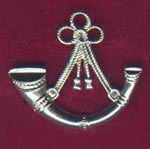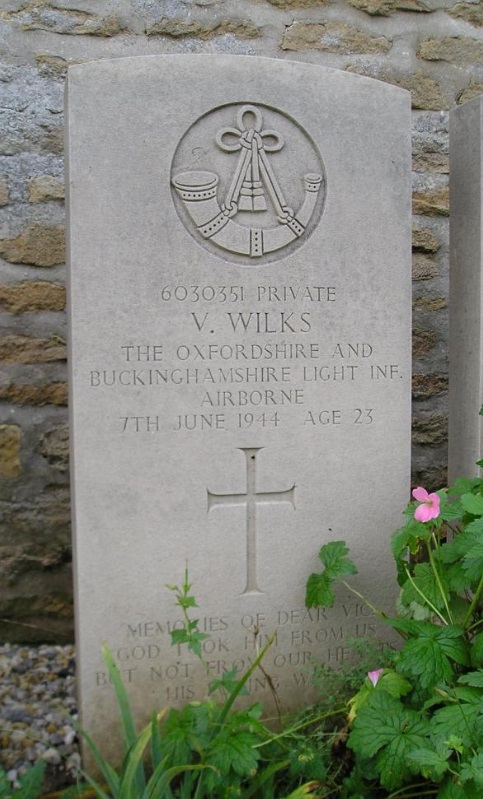Victor Wilks
Victor Wilks was born on 12th August 1920. He was the son of
Herbert Wilks and Mary Ann Wilks (née Claydon) who married in 1908.
The Wilks family moved from Stebbing to Little Dunmow in the summer of 1929. Their address was recorded in the School admissions register as the “Council Houses” probably those newly built at Pound Hill.
Victor, his sisters Lily Ivy and Elsie, and brother Albert were all enrolled at Little Dunmow County School on 19th August 1929. Victor remained at the School until 2nd August 1934 when he was 14 years old.
Victor married Queenie E.P. English early in 1943. They had a daughter Maureen A. Wilks who was born in the latter part of 1944 after Victor's death.
Victor Wilks served as Private soldier 6030351 with the 2nd (Airborne) Battalion of the Oxford and Bucks Light Infantry. He died age 23 on 7th June 1944 as part of the D-Day invasion. He is buried at the Herouvillette New Communal Cemetery.
The 2nd Battalion, Oxfordshire and Buckinghamshire Light Infantry provided the very first troops to land in Normandy in the D Day invasion during the night of 5th and 6th June 1944. Their task was to secure vital bridges, some six miles inland, and to hold them until relieved by the sea borne invasion force.
Shortly after midnight on the morning of 6th June 1944, a force of six Horsa gliders carrying 139 men of the 2nd Ox & Bucks, together with 30 Royal Engineers, all under the command of Major R.J.Howard, landed in darkness to capture the bridges over the Caen Canal (Pegasus Bridge) and the River Orne (Horsa Bridge) by surprise coup de main raid. The attack on Pegasus Bridge was entirely successful and the bridge was held against fierce counter attacks until the Ox & Bucks, joined by 7 Para, were relieved by sea borne troops.
The remainder of the 2nd Battalion the of Ox & Bucks including Victor Wilks landed by glider later on the 6th June and played a major role in the major defensive battles at Escoville and Herouvillette from 7th to 14th June 1944.
Queenie Wilks lived at Corringham after the war with her daughter Maureen. Queenie married Alfred Wilsher in 1946

Ox & Bucks L.I.
Cap Badge

Pegasus Badge of the
Airborne Forces

Headstone at Herouvillette New Communal Cemetery.
2nd Battalion Oxford and Buckinghamshire Light Infantry War Diary 6th and 7th June 1944
6th June 1944
The Regiment less Bridge Assault Party of Letter "D" Company and 2 Platoons of "B" Company, took off from Harwell and Keevil Airfields at 1840 hrs and 1910 hrs respectively. The trip was rather bumpy over land but all became very calm over the sea. At approx 2055 hrs we approached the French coast and could see a large fleet of ships standing off shore and occasional bursts of fire coming from their guns. It was very easy to pick out the River and Canal below and ahead of us and we knew that there had been no mistake in navigation. All gliders except four landed on or somewhere near the landing zone (L.Z.) although in most cases crash landings occurred and many collisions took place. A certain amount of flak as gliders ran in added to the many difficulties of the Glider Pilots who in the majority of cases did magnificently. There was a certain amount of firing on the LZ and some snipers still seemed to be holding out in the area of the bridges at BENOUVILLE. After some delay, due to the fact that some gliders landed rather along way south and also some were very badly smashed which made unloading difficult, the Regt formed up in the area of Rd Junction 098754 at Le Port.
2215 - The Regt began to move forward to cross the bridges to the pre-arranged concentration area at 108744. At this time four glider loads had failed to land, comprising Battalion HQ. No.5, 1 Rifle Platoon 'B' Company, ½ 'B' Company HQ, 1 Mortar Platoon glider. A few people had been hurt in crash landings including the Commanding Officer who managed to carry on and the Loading Officer who had to be evacuated. Major Howard commanding the Bridge Assault Force reported to the Commanding Officer and said that the route to the concentration area was clear. Despite the darkness of the night the Regt moved quickly into the concentration area and a temporary HQ was set up at 109744.
2300 - The Commanding Officer met the Brigade Commander 6 Air Landing Brigade on the bridge at BENOUVILLE and was taken forward to the area of the Church at RANVILLE 116734. The Commanding Officer received orders to move forward into the area of the 13 Parachute Battalion at RANVILLE with intention of occupying HEROUVILLETTE 122724 as soon as possible and then to move on to occupy ESCOVILLE as was originally intended.
7th June 1944
0130 - Regt passed S.P. 110739 moving forward to the Chateau in RANVILLE a temporary H.Q. was set up there. The remainder of the Regt moved into the area of the Chateau grounds and took up a position of all round defence. Elements of the Bridge Assault Party joined us there including Capt B.C.E. Priday and the load from his glider, who having landed in the area of VARAVILLE Bridge, fought their way back to join the Regt.
0230 - 13 Para Battalion had been in contact with the enemy up to dark and reported that he was occupying HEROUVILLETTE. On arrival at the Chateau it was arranged that the Regt should take over the patrolling in front of 13 Para Battalion and 'C' Company was ordered to send out fighting patrols to discover whether the enemy were still in HEROUVILLETTE. These patrols reported by 0430 hrs that there was no sign of the enemy in the village though they had not entered it. 'C' Company was therefore ordered to move forward and seize the Western portion of HEROUVILLETTE and send patrols to discover whether the enemy were holding the Eastern portion. 'A' and 'B' Companies were then to move forward and seize the Eastern portion. Meanwhile the remainder of the Regt were to move fwd to the area of the farm at 119728. This move was completed without opposition by 0830 hrs.
0830 - The Commanding Officer then decided to make a similar advance by bounds to seize and occupy ESCOVILLE the task allotted to the Regiment in the original plan before leaving ENGLAND. 'A' and 'B' Companies patrols moved forward to the village which they reported clear except for a few snipers.
1000 - At 1000 hrs 'A' and 'B' Companies were ordered to move up and occupy the positions already allotted to them and they were followed by 'D' Company and Regimental H.Q. 'C' Company was to remain at HEROUVILLETTE as a firm base until the remainder of the Regt was established in ESCOVILLE. At 1030 hrs the leading Companies reached ESCOVILLE and started to dig in.
1100 - Regimental H.Q. attempted to establish itself in CHATEAU 124714 as arranged but came under accurate fire from an enemy SP gun firing from a hull-down position about 250 yards South of the CHATEAU. Attempts were made to dislodge this enemy gun with 6-pdr guns and PIAT parties but these proved unsuccessful. The SP gun appeared to be well protected by snipers. Meanwhile 'D' Company moved round into its allotted position.
1200 - Companies were in position but experiencing difficulty owing to fire from armoured cars and other SP guns and snipers who appeared to be on a reverse slope position just South of the village and which were continually moving about. We were visited about this time by the Brigade Commander. Battalion. HQ had still failed to get into the CHATEAU and HQ had been set up in a line of trees about 100 yards North of the CHATEAU itself. Shortly after this the enemy started accurate mortar fire in area of Regimental HQ and some casualties were suffered. Owing to very accurate fire from enemy armoured vehicles 'A' and 'D' Companies had been unable to get well forward into good positions of observation and in particular the anti tank guns were unable to get into their allotted positions or even into positions from which they could engaged the enemy SP guns.
1400 - Mortar fire and gun fire continued to be experienced by all Companies and an appreciable number of casualties were incurred. The enemy were very well concealed and although 3" Mortars were brought to bear on any SP guns that showed themselves fire was rather ineffective due to lack of observation.
1500 - The enemy began to become more bold and succeeded in shooting up the right forward Company rather badly. At about this time fire from mortars and SP guns became intensified and enemy infantry began to infiltrate forward supported by tanks and one or two armoured cars. Owing to the fact that the Regt had never managed to get into an organised co-ordinated defensive position and there was considerable danger of becoming outflanked in a position not suitable for defence in view of the fact that ST. HONORINE had not been captured the Commanding Officer asked for permission from Brigade to withdraw to a position on the highest ground in the village of HEROUVILLETTE. This permission was granted.
1600 - The Regt withdrew to HEROUVILLETTE with 'C' Company acting as rearguard protection. A portion of 'D' Company the left forward Company and 'A' Company the right forward Company who were heavily engaged at the time became cut off and had a spirited battle with enemy armoured fighting vehicles. The Vickers Machine Guns with 'A' Company did some very good work before they withdrew. 'B' Company reformed about 400 yards North of ESCOVILLE and were sent in as a counter attack to extricate the fwd Companies. This was successfully accomplished with some casualties.
1700 - The Regt took up a def position in the area of HEROUVILLETTE and commenced to dig in. Reconnaissance Patrols were sent forward to discover the enemy's further intentions. The remainder of the day and night was spent digging in. During the day the Regt had suffered about 60 casualties. The Commanding Officer who had been injured on landing and was unable to get about on foot was evacuated by Medical Authority at about 2100 hrs and command of the Regiment was taken over by Major M. Darrell-Brown second in command.